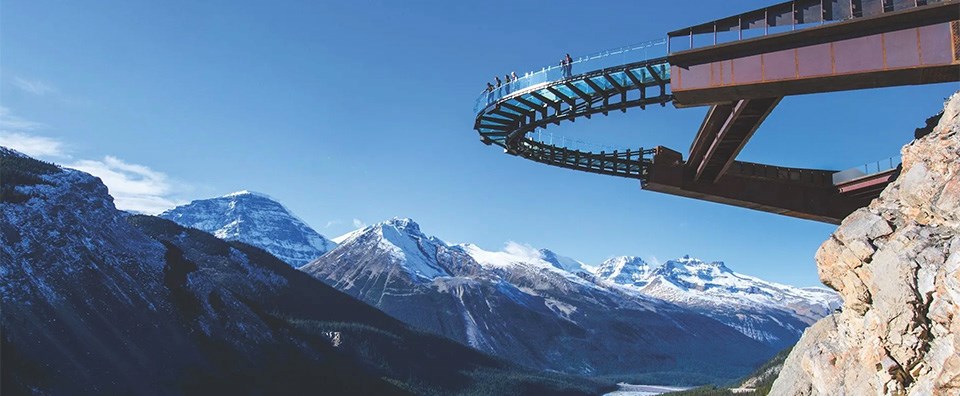From their ancient origins to their changing forms today, Banff’s glaciers are an important part of natural history and a great reminder of nature’s fragility.
What Exactly Is a Glacier?
Glaciers are immense masses of ice that form when layers of snow compact and crystallize over time due to pressure. Unlike the static ice we encounter in freezers, glaciers are dynamic, slowly flowing down slopes under their own immense weight. This movement sculpts the landscape, creating valleys, cliffs, and lakes. Found primarily in regions with high altitudes or polar climates, glaciers are key indicators of Earth's climatic health. Canada, with over 200,000 square kilometres of glacier coverage, is home to many breathtaking examples, particularly in Banff.
Banff’s Glaciers
Banff National Park is dotted with magnificent glaciers that attract locals and tourists alike. Here are some of the notable ones:
- Bow Glacier – The source of the picturesque Bow River, this glacier is visible during hikes around Bow Lake in the park.
- Crowfoot Glacier – Named for its unique shape resembling a three-toed crow’s foot, though one “toe” has melted away over time.
- Hector Glacier – A more remote beauty situated close to Mount Hector.
- Peyto Glacier – Best known for feeding the iconic Peyto Lake, whose wolf-shaped blue waters make it a photographer’s favourite. This one is vanishing fast, so if you want to see it, put it high on your to-do list.
- Ram Glacier – A lesser-known gem for those looking for quieter trails.
- Saskatchewan Glacier – Part of the Columbia Icefield, this glacier contributes to the Saskatchewan River System.
- Vulture Glacier – A smaller glacier perched high in the rugged peaks.
- Wapta Icefield and Waputik Icefield – Vast expanses of interconnected icefields that offer a glimpse into the high-altitude ecosystems of Banff.
How Old Are Banff’s Glaciers?
Banff’s glaciers are remnants of a period roughly 10,000–20,000 years ago, during the last Ice Age. The Cordilleran Ice Sheet once covered much of the area, and these glaciers represent what remains of this epic ice formation. Over millennia, they served as nature's architects, carving out the valleys and depositing the sediment that formed Banff’s unique geological features.
How and Why Have They Changed Over Time?
Banff’s glaciers are shrinking, and the rate of decline is accelerating. Scientists attribute this dramatic retreat to rising global temperatures caused by climate change. Warmer summers and reduced snowfall have created a deficit in the glaciers' ability to replenish themselves. According to studies, up to 70% of Alberta’s glaciers could disappear by 2100 if current trends persist. This loss not only reshapes Banff’s landscape, but it also affects freshwater ecosystems, regional biodiversity, and local communities that depend on glacier-fed waters.
How to Visit the Glaciers and Safety Tips
Exploring Banff’s glaciers offers an unforgettable way to experience their beauty firsthand, but it requires careful planning and respect for safety. Here are some tips:
- Stick to Marked Trails – Avoid venturing onto glaciers without proper equipment and expertise. Crevasses and unstable ice can be dangerous.
- Dress Appropriately – Wear layers and bring essentials like waterproof gear. The weather can change rapidly at high altitudes.
- Travel with a Guide – If you wish to step onto a glacier, strongly consider joining a guided tour. Specialists can ensure your safety and provide in-depth knowledge.
- Stay Hydrated and Pack Snacks – Some areas can be physically demanding, and it’s important to prepare for the altitude and terrain.
Travel Companies to Help You Explore the Glaciers
For a seamless experience, consider booking with one of the reputable travel companies that offer glacier tours. Rocky Mountaineer, for instance, provides luxurious train journeys through the Canadian Rockies, stopping at places like the Columbia Icefield. Their “Journey through the Clouds” route offers breathtaking views of glaciers and other natural wonders. Meanwhile, the Icefields Parkway connects Banff and Jasper National Parks, where the Athabasca Glacier is among the most accessible and visited. Specialized vehicles and the Glacier Skywalk ensure an up-close encounter with nature’s icy marvels.
Additional companies include but are not limited to: Banff Adventures, Banff Tours, and Brewsters Sightseeing.

A Great History, A Disappearing Future
Banff’s glaciers are more than stunning natural attractions. They hold vital clues to Earth's climatic past while shaping the ecosystems we know today. Their striking beauty and ecological importance make them treasures worth preserving for generations to come. Whether you’re marvelling at the waters of a glacier-fed lake or hiking the surrounding alpine trails, you’re witnessing a piece of history slowly transforming before your eyes. See it before it melts away.
Plan your visit to Banff National Park, experience the glaciers for yourself and be an advocate for nature by exploring responsibly and supporting conservation efforts.
Have you visited Banff’s glaciers? Share experience in the comments.
Learn More: Interactive Fun Online
If you’re fascinated by glaciers and want to explore them further from the comfort of your home, there are several interactive online resources to check out. The Antarctic Glaciers website offers engaging interactive glacier models ideal for students and teachers to visualize glacier mechanics. For a fun and educational experience, Science Trek’s glacier games provide a chance to test your knowledge and learn in an interactive way. Additionally, the OGGM Edu Glacier Simulator allows you to experiment with glacier dynamics and see how environmental factors influence their behaviour; try it out here.
Nerissa McNaughton is a freelance writer and a contributor to Great West Media. This story was written for Great West Media's Hot Summer Guide advertising feature. The Hot Summer Guide is a special feature about summer activities, bucket list adventures, staycation options, road trips, attractions, events, and road trip-worthy food & beverage destinations across Alberta. It is not written by and does not necessarily reflect the views of the editorial staff.



